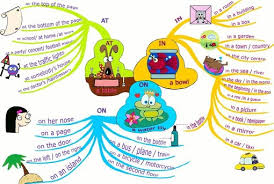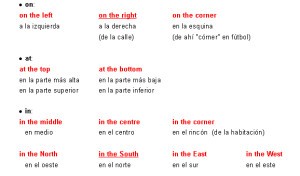Preposiciones en inglés, son utilizadas sobretodo cuando el objeto directo es un pronombre.
Las construcciones con su omisión son las más frecuentes salvo en el caso anterior, cuando por ejemplo podemos decir:
He sent a Book to Tom
O
She sent Tom a book
He kept a seat for Bill
O
He kept to Bill a seat
Asimismo podemos diferenciar distintas clases de preposiciones…
Preposiciones en ingles, date and time

“at” a time
Por ejemplo:
At six o’clock
“At” noon
“At” midnight
“on” Monday
“on july 23rd
“on” christmas day
“On” a day:
“On” Monday
“On” july 23rd
“On” christmas day
“in” a period:
“in august
“in 2013
“in summer
“in the morning
“in the afternoon
Preposiciones en ingles, excepciones
Como excepciones para estos casos anteriores podemos citar:
“at” night
“at” easter
“at” christsmas (easter and christsmas cuando se refiere a todo el período, no al día en particular)
“on” the time (a la hora exacta)
“in” time (a tiempo, no tarde)
“in” the time también puede significar: eventually / in the end.
Preposiciones en ingles, movimiento y viaje
Movement and travel preposiciones son las siguientes:
From, by, on, in, at, to, into, onto, out of, off.
Veamos sus usos con ejemplos prácticos:
We travel “from” our atarting point “to” our destination
Nosotros viajamos desde nuestro punto de partida hacia nuestro destino.
We travel “by” train
Nosotros viajamos en tren.
We travel “on bicycle
Nosotros viajamos en bicicleta
We arrive “in” a town
Llegamos a una ciudad
We arrive “in” a country
Llegamos a un país
We arrive “at” / “in” a village
Llegamos a un pueblo
We arrive “at” cualquier destino por ejemplo: a una dirección, a un hotel o a una estación
We “get to” any destination (llegamos a cualquier destino)
Puede ser usado “onto” pero únicamente para pueblos o ciudades.
Excepciones de estas preposiciones en ingles:
Como excepciones ten en cuenta que:
We rerturn, travel, go home (no se usa la preposición “to”)
We arrive home (sin usar “at”) salvo cuando “home es precedida por un pronombre o nombre, por ejemplo:
We went “to Jack’s home
O We arrive at Jack’s home
Preposiciones en inglés, in /at

Puedes decir…
We can be at an address, a small village, a certain point such as at work, at home, at a bus stop, at a bridge…
We can be “in” a village, a country, a street, a room, a field.
Pero puedes decir…
We are “at” a village, a country, a field, queriendo decir que has llegado a estos lugares.
We can be “in” /”at” a swimming poll, a river, the sea.
“at” aquí significa “encima” /”besides”
“In” significa ahora in el agua /actually in the water
Pero “at sea (sin “the”) significa “on the ship”
We can be “in” /”at” a building.
“At” significa “inside” o (en la planta del edificio) in the ground of the building
Preposiciones en inglés, into /in
“In” es usada para posiciones
Por ejemplo:
The boys are in bed
Los niños están en cama.
She is in the house
Ella está en la casa
She is in the swimming poll
Ella está en la piscina
“into” es usada on un verbo de acción para indicar una entrada
Por ejemplo:
She goes into her house
Ella entro a la casa
He goes into the army
El entró a la armada
Preposiciones en inglés, otras

Till /until
“to” puede ser usada para tiempo y lugar, >”until” / “hill” solo para tiempo
“to” y “Hill se usan para tiempo:
I work from 6 to 8 o “from 6 “Hill” 8
Si no se usa “from” se coloca “till” (no “to”)
Let’s star now and work “till” dark
“till se usa por lo general con un verbo en negativo para dar énfasis
We don’t get home “till 8
“till” puede usarse como una conjunción de tiempo:
Wait “till” I come back
“from” / “since”
“from” puede usarse para lugar y tiempo
She waited “from” 4 “till” 6
He went “from” Montana “to” London
“since” se usa para tiempo nunca para lugar y significa: “desde un tiempo hasta el momento en el que se está hablando”
I’ve been here “since” Saturday “to” now.
“during” / “for”
“for” se usa para un período de tiempo definido. Por lo general seguido por un sustantivo singular precedido por “a”, un sustantivo en plural, un adjetivo de cantidad o “ever:
“for a long time
“for… days
“for” ever
Implica que la acción continúa.
“during” se usa antes de períodos de tiempo:
During the summer
During the time
Furing the holidays
“alter” / “afterwords”:
“alter” necesita ser seguida de un sustantivo, gerundio o pronombre. Si no hay prnombre, gerundio o sustantivo se usa “afterwords o “then”
“After” finding a hotel we went to look at the town
We found a hotel and then (o afterwards) went to look at the town
Lee: cómo estás en inglés.
[…] Estos son todos los deportes más conocidos que puedes aprender en idioma inglés, aprovecha el listado para realizar tu tarea o si estás por viajar a un país del extranjero cuya lengua oficial es el inglés podrás ampliar considerablemente tu vocabulario inclusive si lo sabes aplicar correctamente utilizando: preposiciones en inglés. […]
[…] de una preposición (lee preposiciones en inglés): With him, by them, for us Dative form se usa como objeto indirecto para reemplazar to + […]